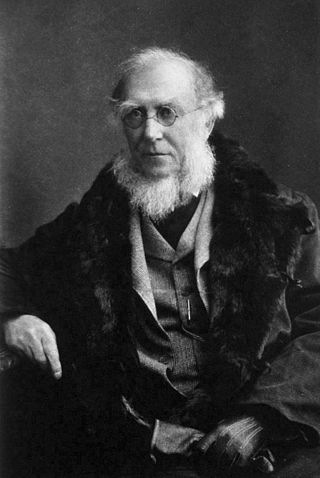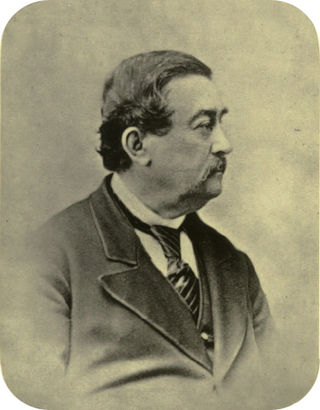
William Theobald (1829 – 31 March 1908) was a malacologist and naturalist on the staff of the Geological Survey of India serving in Burma, then a part of British India. [1]

William Theobald (1829 – 31 March 1908) was a malacologist and naturalist on the staff of the Geological Survey of India serving in Burma, then a part of British India. [1]
Very little is known of Theobald's early life. Theobald was referred to in official documents as "William Theobald, Junior". He arrived in Calcutta on the ship Hindostan via the Suez in March 1847 and worked as a volunteer in the coal exploration of the upper Damodar and Son valleys under David Williams. During this time Joseph Hooker visited him and they spent time together. [2] Later Theobald became an assistant to John McClelland who took over the exploration from David Williams. He went to Burma in 1855 as a staff of the Geological Survey of India and took over the Pegu survey. He returned Bengal on completion of the survey in 1873 to be appointed Deputy Superintendent of Bengal in 1876. [2] From 1868 to 1876 he described a dozen new species of reptiles. [3]
Theobald was the first to publish a full catalogue of reptile specimens collected in British India, Descriptive Catalogue of the Reptiles of British India (1876), [4] although Anderson claimed that several new descriptions by Edward Blyth were overlooked by this work. [1] Theobald's work on Indian freshwater snails with illustrations was one of the first of its kind. [5] He even made his shell collections available to Francis Mason for his epic work on the flora and fauna of British Burma titled Burmah, its People and Natural Productions. The third edition of this work was completely rewritten by Theobald and was published in two volumes under the title Burma, its people and productions; or notes on the fauna, flora and minerals of Tenasserim, Pegu and Burma (Hertford, England, 1882 & 1883). [2] The first volume of this work covered geology, mineralogy and zoology and was exclusively written by him while the second volume relied on several important botanical works of his time. The phanerogamic information came from printed works of Sulpiz Kurz on the Burmese flora and from the entries in Edward Balfour's works. He also relied on Le Maout's and Decaisne's general system of botany translated by Mrs. Hooker and on Gamble's Manual of Indian Timbers. [2] However, his efforts at reforming botanical nomenclature conflicted with the British Botanical establishment at that time a majority in British India and his botanical works were largely disregarded. [2]
He retired from the service in June 1881 and died at Ilfracombe, Devon, England on 31 March 1908. A photograph of him as member of a group of the Geological Survey of India was published in the Centenary publication of the Geological Survey of India. [2]
Theobald is commemorated in the scientific names of two Asian reptiles: Oligodon theobaldi and Phrynocephalus theobaldi . [4]

Sir Joseph Dalton Hooker was a British botanist and explorer in the 19th century. He was a founder of geographical botany and Charles Darwin's closest friend. For 20 years he served as director of the Royal Botanical Gardens, Kew, succeeding his father, William Jackson Hooker, and was awarded the highest honours of British science.

Thomas Caverhill Jerdon was an English physician, zoologist and botanist. He was a pioneering ornithologist who described numerous species of birds in India. Several species of plants and birds including Jerdon's baza, Jerdon's leafbird, Jerdon's bushlark, Jerdon's nightjar, Jerdon's courser, Jerdon's babbler and Jerdon's bush chat are named after him.

Colonel Samuel Richard Tickell was an English soldier, artist, linguist and ornithologist in India and Burma.

Richard Lydekker was an English naturalist, geologist and writer of numerous books on natural history.

Phrynocephalus theobaldi is a species of lizard in the family Agamidae. The species is endemic to Asia.

The Sikkim keelback is a species of grass snake in the family Colubridae. The species is endemic to South Asia and Myanmar. It is closely related to the Himalayan keelback, and some treat this species as a synonym.
Oligodon theobaldi, commonly known as the Mandalay kukri snake or Theobald's kukri snake, is a species of snake in the family Colubridae. The species is endemic to Asia.

Charles Baron Clarke was a British botanist. He worked in as a civil servant in British India in the Bengal education department. He was also keenly interested in botany and held the position of superintendent of the Calcutta Botanical Gardens from 1869 to 1871. During this period he became a specialist on the Cyperaceae and based on their distributions developed an influential phytogeographical classification of British India.

Pupisoma is a genus of minute, air-breathing land snails, terrestrial pulmonate gastropod molluscs or micromollusks in the family Valloniidae.

Ariophanta is a genus of air-breathing land snails, terrestrial pulmonate gastropod mollusks in the subfamily Ariophantinae of the family Ariophantidae.
Sylvanus Charles Thorp Hanley (1819–1899) was a British conchologist and malacologist who published the first book on shells using the then new technique of photography. He authored Conchologia indica with William Theobald which was a treatise on the shells of British India. The plates were drawn and lithographed by George Brettingham Sowerby the younger, who was well known for writing and illustrating excellent works of natural history, especially conchological works. Sowerby became the best illustrator of conchological works of his time, illustrating such classics as Reeve's monumental twenty-volume Conchologia Iconica.
William Henry Benson was a civil servant in British India and a pioneer malacologist. He made large collections of molluscs and described over 470 species, mainly from India, Sri Lanka, Burma and South Africa.

Corilla is a genus of air-breathing land snails, terrestrial pulmonate gastropod mollusks in the family Corillidae. This family has no subfamilies. It has been synonymised with Atopa Albers, 1850 and Helix (Corilla) Adams & Adams, 1855.

Macrochlamys is a large genus of air-breathing land snails, terrestrial pulmonate gastropod mollusks in the family Ariophantidae.

Staffordia daflaensis is a species of air-breathing land snail, terrestrial pulmonate gastropod mollusk in the family Staffordiidae.

Staffordia staffordi is a species of air-breathing land snail, terrestrial pulmonate gastropod mollusk in the family Staffordiidae.

Khasiella is a genus of air-breathing land snails, terrestrial pulmonate gastropod mollusks in the family Ariophantidae.

Charles Samuel Pollock Parish (1822–1897) was an Anglo-Indian clergyman and botanist who served as chaplain to the forces of the Honourable East India Company in Burma. With his wife Eleanor he collected and painted plants, chiefly orchids, identifying and naming a number of species new to science. Several species are named in his honour.

Zonitoides notabilis is a species of small, air-breathing land snail, a terrestrial pulmonate gastropod mollusk in the family Gastrodontidae.